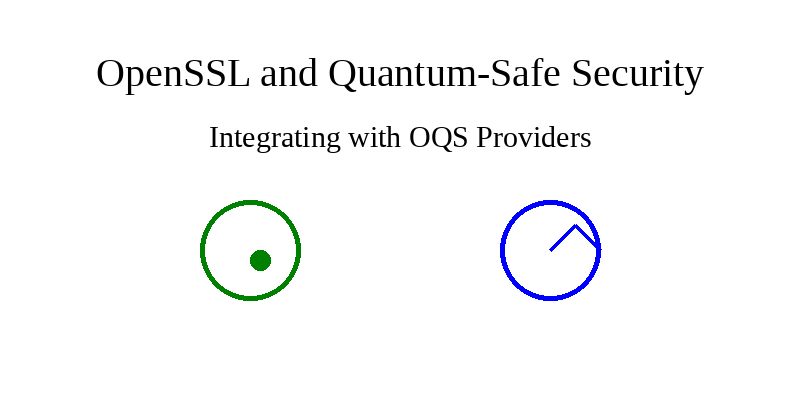In the rapidly evolving landscape of quantum computing, ensuring quantum-safe security protocols is more critical than ever. OpenSSL, a widely used toolkit for SSL and TLS protocols, has extended its capabilities to include support for quantum-safe algorithms through Open Quantum Safe (OQS) providers. This integration heralds a new era in cybersecurity, preparing systems for the quantum future.
What are OpenSSL OQS Providers?
OpenSSL OQS providers are modules that enable OpenSSL to utilize quantum-resistant algorithms. These providers are crucial for maintaining secure communication in the post-quantum era. They integrate seamlessly with OpenSSL, ensuring compatibility with existing systems while offering advanced protection against quantum threats. Installing and Activating an OQS Provider
Setting the Stage for OpenSSL and OQS Integration
-
Environment Preparation: We begin by setting up our environment, designating directories for OpenSSL (
/opt/openssl), liboqs (/opt/liboqs), and the OQS provider (/opt/oqs-provider). These paths are crucial for organized installation and management. -
Script Mechanics: Our script employs error handling (
set -e) to ensure any issues are caught promptly. It’s all about precision and efficiency, utilizing available CPU cores ($(nproc)) to expedite the build process. -
Clean Slate: We clear out any existing directories (
/optbuild/liboqs,/optbuild/openssl,/optbuild/oqs-provider) to avoid conflicts and ensure a fresh start.
#!/bin/bash
# Enable error handling
set -e
# Set up environment and variables
INSTALLDIR_OPENSSL="/opt/openssl"
INSTALLDIR_LIBOQS="/opt/liboqs"
INSTALLDIR_PROVIDER="/opt/oqs-provider"
LIBOQS_BUILD_DEFINES="ON"
OQS_ALGS_ENABLED="STD"
OQS_MINIMAL_BUILD="KEM_kyber_768"
MAKE_DEFINES="-j $(nproc)" # Use all available cores
SIG_ALG="dilithium3"
# clenup dirs if exists
echo "clenup dirs if exists"
rm -rf /optbuild/liboqs /optbuild/openssl /optbuild/oqs-provider
The Integration Odyssey
-
Cloning Repositories: The journey involves cloning the latest versions of OpenSSL, liboqs, and the OQS provider from their respective GitHub repositories. This step is crucial to obtain the most up-to-date and secure versions.
# List of repositories and branches to clone repos=( "https://github.com/openssl/openssl.git openssl-3.2" "https://github.com/open-quantum-safe/liboqs main" "https://github.com/open-quantum-safe/oqs-provider.git main" ) # Function to clone a repository clone_repo() { repo_url=$(echo "$1" | awk '{print $1}') branch=$(echo "$1" | awk '{print $2}') if git clone --depth 1 --branch "$branch" "$repo_url"; then echo "Successfully cloned $repo_url" else echo "Error cloning $repo_url" >&2 exit 1 fi } # Export it so it's available to parallel export -f clone_repo mkdir -p /optbuild && cd /optbuild || exit # Call the function with xargs printf '%s\n' "${repos[@]}" | xargs -I {} -P 4 bash -c 'clone_repo "$@"' _ {} - Building OpenSSL:
Next, we compile and install OpenSSL, tweaking library paths to ensure smooth operation. This step lays the groundwork for integrating the OQS provider.
# Build OpenSSL cd openssl || exit LDFLAGS="-Wl,-rpath -Wl,${INSTALLDIR_OPENSSL}/lib64" ./config shared --prefix="${INSTALLDIR_OPENSSL}" make ${MAKE_DEFINES} 2>&1 >/dev/null make install 2>&1 >/dev/null if [ -d "${INSTALLDIR_OPENSSL}/lib64" ]; then ln -s "${INSTALLDIR_OPENSSL}/lib64" "${INSTALLDIR_OPENSSL}/lib" fi if [ -d "${INSTALLDIR_OPENSSL}/lib" ]; then ln -s "${INSTALLDIR_OPENSSL}/lib" "${INSTALLDIR_OPENSSL}/lib64" fi - Assembling liboqs:
We then build liboqs with custom settings to enable specific quantum-safe algorithms, adjusting for performance and compatibility.
# Build liboqs cd /optbuild/liboqs || exit mkdir -p build cmake -S . -B build \ -DCMAKE_ASM_FLAGS='-Wa,--noexecstack' \ -DOPENSSL_ROOT_DIR="${INSTALLDIR_OPENSSL}" \ -DCMAKE_BUILD_TYPE=Debug \ -DOQS_ALGS_ENABLED="${OQS_ALGS_ENABLED}" \ -DOQS_DIST_BUILD="${LIBOQS_BUILD_DEFINES}" \ -DOQS_OPT_TARGET=generic \ -DOQS_MINIMAL_BUILD="${OQS_MINIMAL_BUILD}" cmake --build build --parallel $(nproc) cmake --build build --target install - OQS Provider Installation:
Finally, the OQS provider is compiled and installed. We tweak the OpenSSL configuration to recognize and activate the new provider, marking the culmination of our integration process.
# Build oqs-provider cd /optbuild/oqs-provider || exit liboqs_DIR="${INSTALLDIR_LIBOQS}" cmake -DOPENSSL_ROOT_DIR="${INSTALLDIR_OPENSSL}" -DCMAKE_BUILD_TYPE=Release -DCMAKE_PREFIX_PATH="${INSTALLDIR_OPENSSL}" -S . -B _build cmake --build _build cmake --install _build cp _build/lib/oqsprovider.so "${INSTALLDIR_OPENSSL}/lib64/ossl-modules" sed -i "s/default = default_sect/default = default_sect\noqsprovider = oqsprovider_sect/g" "${INSTALLDIR_OPENSSL}/ssl/openssl.cnf" sed -i "s/\[default_sect\]/\[default_sect\]\nactivate = 1\n\[oqsprovider_sect\]\nactivate = 1\n/g" "${INSTALLDIR_OPENSSL}/ssl/openssl.cnf" sed -i "s/providers = provider_sect/providers = provider_sect\nssl_conf = ssl_sect\n\n\[ssl_sect\]\nsystem_default = system_default_sect\n\n\[system_default_sect\]\nGroups = \$ENV\:\:DEFAULT_GROUPS\n/g" "${INSTALLDIR_OPENSSL}/ssl/openssl.cnf" sed -i "s/HOME\t\t\t= ./HOME = .\nDEFAULT_GROUPS = kyber768/g" "${INSTALLDIR_OPENSSL}/ssl/openssl.cnf" - Verification:
A key step is to verify our setup. We check the OpenSSL version and list the available providers to confirm that our OQS provider is successfully integrated.
# Verify openssl version and providers /opt/openssl/bin/openssl version -a /opt/openssl/bin/openssl list -providers
The script found github gist as well https://gist.github.com/vkosuri/09a7e66a745d6cf3933e76100e5e729e
Embracing a Quantum-Safe Future
This script doesn’t just represent a set of commands; it’s a gateway to a new era of quantum-safe encryption. By integrating OQS providers with OpenSSL, we’re taking a proactive stance against the looming quantum threat, ensuring our digital communications remain secure and confidential.
In conclusion, the integration of OpenSSL with OQS providers is more than a technical task; it’s a necessary step in our ongoing journey towards a secure digital future. This guide, inspired by a shell script, is a testament to the power of open-source collaboration and innovation in the face of emerging cybersecurity challenges.

 Unlocking the Power of ICAP Protocol: A Comprehensive Guide 🌐💡
Unlocking the Power of ICAP Protocol: A Comprehensive Guide 🌐💡